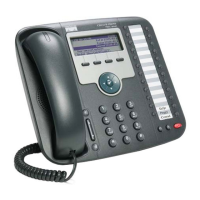3-3
Cisco Unified IP Phone 7931G Administration Guide for Cisco Unified Communications Manager 8.0 (SCCP and SIP)
OL-20798-01
Chapter 3 Setting Up the Cisco Unified IP Phone
Understanding the Cisco Unified IP Phone 7931G Components
Understanding the Cisco Unified IP Phone 7931G Components
The Cisco Unified IP Phone 7931G includes these components on the phone or as accessories for the
phone:
• Network and Access Ports, page 3-3
• Handset, page 3-3
• Speakerphone, page 3-3
• Headset, page 3-4
Network and Access Ports
The back of the Cisco Unified IP Phone includes these ports:
• Network port—Labeled 10/100 SW
• Access port—Labeled 10/100 PC
Each port supports 10/100 Mbps half- or full-duplex connections to external devices. You can use either
Category 3 or 5 cabling for 10-Mbps connections, but you must use Category 5 for 100 connections.
Use the SW network port to connect the phone to the network. You must use a straight-through cable on
this port. The phone can also obtain inline power from a switch over this connection. For details, see
Providing Power to the Phone, page 2-3.
Use the PC access port to connect a network device, such as a computer, to the phone. You must use a
straight-through cable on this port.
Handset
The handset is designed especially for use with the Cisco Unified IP Phone 7931G. It includes a light
strip that indicates incoming calls and voice messages waiting.
To connect a handset to the Cisco Unified IP Phone, plug the cable into the handset and the Handset port
on the back of the phone.
Note The handset does not support wideband audio.
Speakerphone
By default, the speakerphone is enabled on the Cisco Unified IP Phone 7931G.
You can disable the speakerphone by using the Cisco Unified Communications Manager
Administration. To do so, choose Device > Phone and locate the phone you want to modify. In the Phone
Configuration window for the phone, check the Disable Speakerphone check box.

